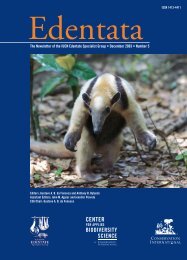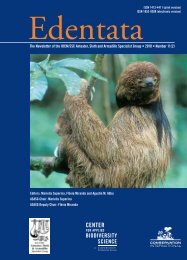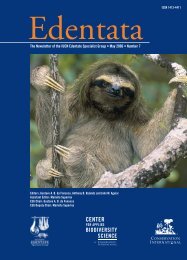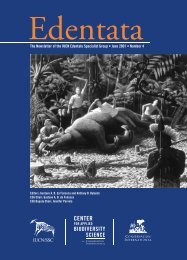Edentata 11(1) - Anteater, Sloth & Armadillo Specialist Group
Edentata 11(1) - Anteater, Sloth & Armadillo Specialist Group
Edentata 11(1) - Anteater, Sloth & Armadillo Specialist Group
Create successful ePaper yourself
Turn your PDF publications into a flip-book with our unique Google optimized e-Paper software.
Presence of Amblyomma cajennense in Wild<br />
Giant <strong>Armadillo</strong>s (Priodontes maximus) of the<br />
Pantanal Matogrossense, Brazil<br />
Abstract<br />
Flávia Regina Miranda<br />
Rodrigo Hidalgo Friciello Teixeira<br />
Gilberto Salles Gazêta<br />
Nicolau Maués Serra-Freire<br />
Marinete Amorim<br />
The giant armadillo (Priodontes maximus) is the<br />
largest extant representative of the order Cingulata.<br />
Information on the parasites and diseases affecting<br />
this species is scarce. Four female and one male ticks<br />
were collected from two wild-caught, adult giant<br />
armadillos from the northern Pantanal, Mato Grosso,<br />
Brazil. All of them were identified as Amblyomma<br />
cajennense. This is the first report of A. cajennense in<br />
giant armadillos. Considering the low host specificity<br />
of this ixodid tick that may act as vector of pathogens,<br />
and the sustained encroachment of domestic animals<br />
into wildlife habitat, the risk of disease transmission<br />
from cattle to this threatened armadillo should be<br />
evaluated.<br />
Keywords: Ticks, Ixodidae, Xenarthra, Cingulata<br />
The giant armadillo (Priodontes maximus) is the largest<br />
extant representative of the order Cingulata. It is currently<br />
listed as Vulnerable by the IUCN Red List of<br />
Threatened Species (Superina et al., 2009). It occurs<br />
east of the Andes from Venezuela, Colombia, and the<br />
Guyanas to Paraguay, Argentina, and Brazil (Wetzel,<br />
1982). The giant armadillo may occupy different habitats,<br />
from low and highland forests to lands covered<br />
with thorny shrubs and cerrado, although open areas<br />
are its favorite habitat (Anacleto, 1997). Information<br />
on the parasites and diseases affecting this species is<br />
scarce (Superina, 2000).<br />
Systematic collection of parasites in wild animals can<br />
provide important information for the management<br />
of captive and free-ranging populations. The Ixodidae<br />
family is composed of 14 genera and approximately<br />
670 species of hard ticks (Anderson, 2002). They<br />
have a dorsal shield that covers the entire idiosome<br />
in males, but only the anterior area in females and<br />
immature stages (larvae and nymphs). In addition,<br />
nymphs and adults have respiratory stigmas posterior<br />
to coxa IV (Anderson, 2002). Ixodid ticks are<br />
highly physiologically dependent of their hosts and<br />
can be vectors of a variety of pathogens that can cause<br />
disease in humans, domestic animals, and wildlife<br />
(Anderson and Magnarelli, 2008). Infectious agents<br />
may be transmitted transtadially (larva to nymph or<br />
nymph to adult) or transovarially, i.e., from generation<br />
to generation, as well as passed on to their hosts<br />
while obtaining a blood meal.<br />
In Brazil, the first records of ticks of free-ranging<br />
mammals were provided by Aragão (1936), Fonseca<br />
and Aragão (1952, 1953), and Aragão and Fonseca<br />
(1961). Later reports include Serra Freire et al. (1996);<br />
Castro and Serra Freire (1996); Amorim et al. (1998);<br />
Evans et al. (2000); Guerra et al. (2000); Martins et al.<br />
(2004); and Miziara et al. (2008). Here, we report for<br />
the first time the presence of Ixododidae in wild giant<br />
armadillos (Priodontes maximus).<br />
This study was conducted at the Reserva Particular de<br />
Patrimônio Natural do Serviço Social do Comércio,<br />
Pantanal (RPPN SESC Pantanal; 16°39'S, 56°15'W),<br />
a Conservation Unit located in the northern portion<br />
of the Pantanal, state of Mato Grosso, Brazil. Two<br />
adult giant armadillos (Priodontes maximus), a male<br />
and a female, were captured by hand and chemically<br />
restrained with 10 mg/kg ketamine and 0.2 mg/kg<br />
midazolam. A clinical examination was performed<br />
and blood samples extracted. Ticks found attached<br />
to the armadillos were manually removed by twisting<br />
them around the longitudinal axis of their idiosome,<br />
preserved in 70% ethyl alcohol, and sent to the Ixodides<br />
Laboratory at the National Reference Center<br />
for Vectors of Rickettsias of the Oswaldo Cruz Foundation<br />
(FIOCRUZ) in Rio de Janeiro. The parasites<br />
were examined using a stereomicroscope and identified<br />
according to the dichotomic keys of Aragão and<br />
Fonseca (1961) and Barros-Battesti et al. (2006).<br />
Three female ticks were found on one armadillo,<br />
while the other was infested by a male and female<br />
tick. All of them were identified as Amblyomma cajennense<br />
(Fig. 1).<br />
This is the first report of A. cajennense in P. maximus.<br />
Several ticks of this genus have been described in<br />
other armadillos. For instance, A. auricularium and<br />
A. pseudoconcolor have been observed on Dasypodidae<br />
(Guglielmone et al., 2003). A. brasiliense was<br />
found in Dasypus septemcinctus and D. novemcinctus<br />
(Evans et al., 2002), A. auricularium in D. novemcinctus<br />
(Amorim and Serra-Freire, 2000; Olegário et al.,<br />
2006), A. fuscum in D. septemcinctus (Aragão, 1936;<br />
Brum et al., 2003), and A. parvum in D. kappleri<br />
(Mullins et al., 2004).<br />
<strong>Edentata</strong> no. <strong>11</strong>(1) • 2010 73














